
S.Warren. Designing organic syntheses
..pdf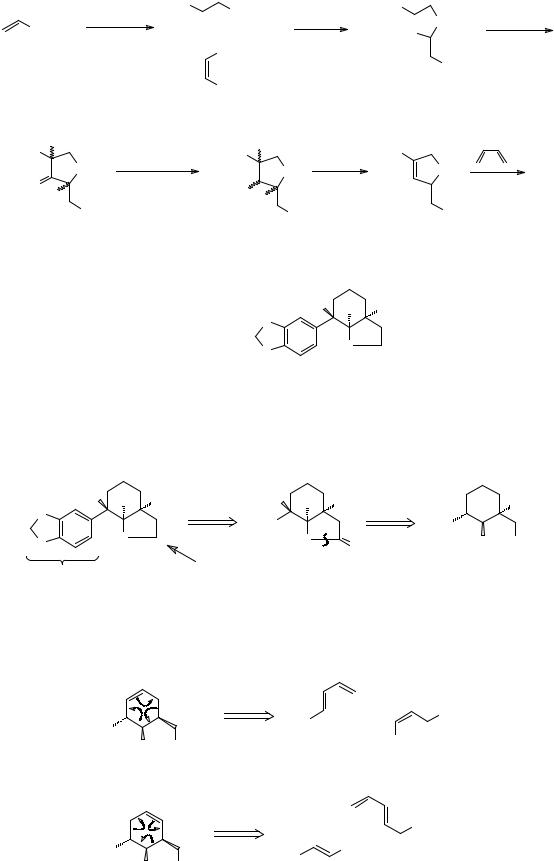
87
|
|
HS |
|
CO2Me |
MeO2C |
- |
|
|
|
H2S |
|
||||
CO2Me |
|
+ |
|
|
S |
MeO |
|
|
base |
CO2Me |
|
MeO2C |
MeOH |
||
|
|
|
|
|
|
||
|
|
|
|
|
CO2Me |
|
|
|
|
|
|
|
|
|
|
|
|
|
|
CO2Me |
|
|
|
MeO2C H |
|
diborane |
|
MeO2C |
H |
MeO2C |
|
|
S |
|
|
P2O5 |
S |
|
|
O H |
reduction |
|
|
S |
TM 269 |
||
|
|
HO |
|
|
|
||
|
|
|
H |
|
|
||
|
|
|
|
|
|
|
|
|
CO2Me |
|
|
CO2Me |
CO2Me |
|
|
_______________________________________
271. Review Problem 27: Design a synthesis for TM 271:
|
|
H |
H H |
|
O |
|
|
|
|
|
|
TM 271 |
O |
|
HN |
|
|
|
_______________________________________
272 . This is perhaps the most difficult problem so far; there must be many possible solutions and I can give only one.
Analysis: Since there is one CH2 group next to the nitrogen atom, this might be a carbonyl group in our usual method of amine synthesis (frame 237).
|
H |
H |
H |
H |
H |
H |
|
C - N |
H |
O |
|
|
|||||||
|
|
|
FGI |
|
|
|
|
||
|
|
|
|
Ar |
|
|
|
Ar |
|
O |
|
HN |
|
|
HN |
|
O |
H2N |
CO2Et |
|
|
|
|
|
|
|
|
|
Ar
We must next disconnect the six-membered ring and the only way we know to set up these chiral centres specifically is by the Diels-Alder reaction. Two alternative sites for the double bond are possible if we convert our NH2 to give the necessary activating group: (NO2)
a)
|
|
D - A |
CO2Et |
|
Ar |
|
Ar |
||
|
|
|||
|
NO2 |
A |
||
O2N |
CO2Et |
|||
|
|
b)
|
|
D - A |
CO2Et |
|
|
|
|
Ar |
|
|
NO2 |
O2N |
CO2Et |
|
Ar |
|
B |
||
|
|
|
While we can make the trans nitro-alkene B easily enough, the cis-nitro alkene A would present problems, so let's try route b:
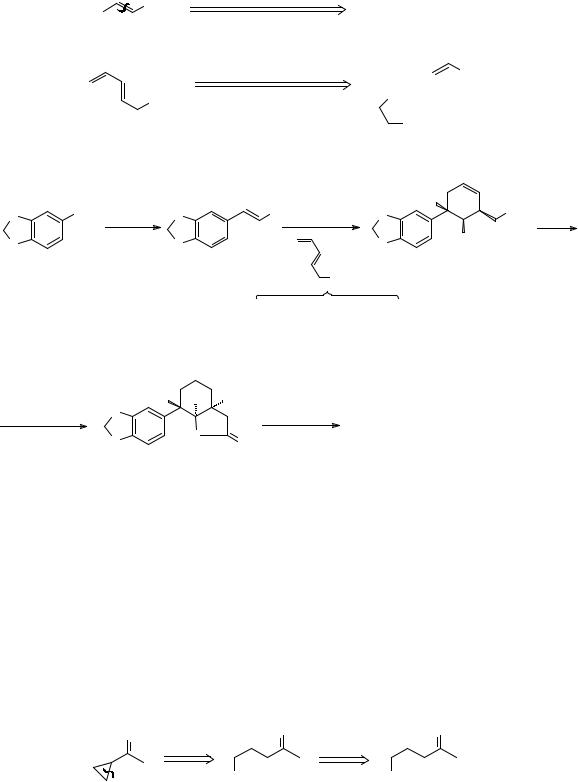
|
|
88 |
|
|
NO2 |
α,β −unsaturated |
ArCHO + CH3NO2 |
Ar |
|
||
|
nitro compound |
||
|
|
|
|
|
|
Wittig |
CHO |
|
|
|
+ |
|
CO2Et |
? |
PPh3 |
|
or other methods |
|
|
|
|
|
|
|
|
|
CO2Et |
Synthesis: This is the method used in the synthesis of TM 271 as an intermediate for α-lycorane (J. Amer. Chem. Soc., 1962, 84, 4951).
|
|
|
|
|
H |
O |
CHO MeNO2 |
O |
NO2 |
O |
CO2Et |
O |
base |
O |
|
O |
NO2 |
CO 2Et
Ph3P
 CHO +
CHO +  CO2Et
CO2Et
|
H |
H |
H |
H2 , Ni |
O |
|
LiAlH4 |
|
|
HN |
TM 271 |
|
O |
O |
|
|
|
_______________________________________
H.SPECIAL METHODS FOR SMALL RINGS: 3- AND 4-MEMBERED RINGS
1.THREE-MEMBERED RINGS
273. Three membered rings are kinetically easy to form but are rather unstable. Some conventional methods work but are rather capricious. This obvious disconnection on cyclopropyl ketones turns out to be all right:
O O O
|
- |
Hal |
Hal |
TM 273
How would you make the γ-haloketone TM 273?
_______________________________________
274. The obvious disconnection gives an epoxide and an enolate anion:
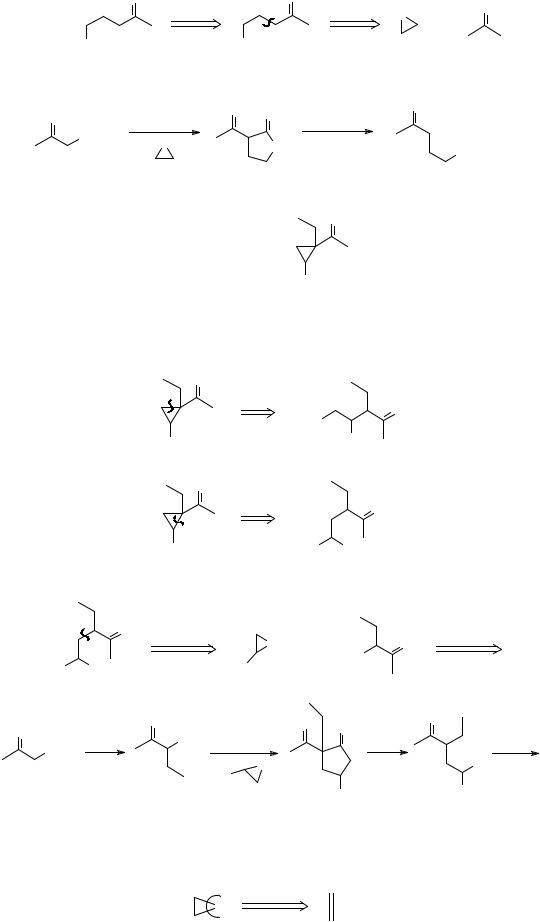
|
|
89 |
|
|
O |
O |
O |
|
FGI |
O |
|
|
|
+ - |
|
Hal |
OH |
|
We have already explored this route (frame 184) and found that the reaction sequence actually is:
O |
|
- |
O |
O |
O |
|
|
HBr |
|
||||
|
EtO |
|
|
|
||
|
CO2Et |
O |
|
O |
Br |
= TM 273 |
|
|
|
||||
|
|
|
|
|
|
How then would you make TM 274?
O
TM 274
Ph
_______________________________________
275. Analysis: We must consider two alternative disconnections of the three-membered ring:
O
a |
|
- |
O |
|
|
|
|
|
Br |
|
|
Ph |
|
Ph |
A |
O |
|
- |
|
b |
|
O |
|
Ph |
Ph |
Br |
B |
|
Since epoxides are attacked by anions at the less substituted carbon atom, we shall be able to make B but not A, so we continue.
|
O |
+ FGI |
O |
+ |
|
|
|
|
O |
etc. |
|||
|
|
|
||||
Ph |
Br |
Ph |
|
|
EtO2C |
|
|
|
|
|
|||
Synthesis: |
|
|
|
|
|
|
|
O |
|
|
O |
O |
O |
O |
|
|
|
|||
EtO- |
CO2Et EtO- |
|
|
HBr |
base |
|
CO2Et |
|
|
||||
|
|
|
|
|
TM 274 |
|
|
EtI |
Ph |
O |
|
|
Br |
|
|
|
|
|
|
|
|
|
|
|
|
Ph |
Ph |
_______________________________________
276. A more general route to three-membered rings is based on a new type of disconnection: the removal of an atom
|
+ |
.. |
X |
X |
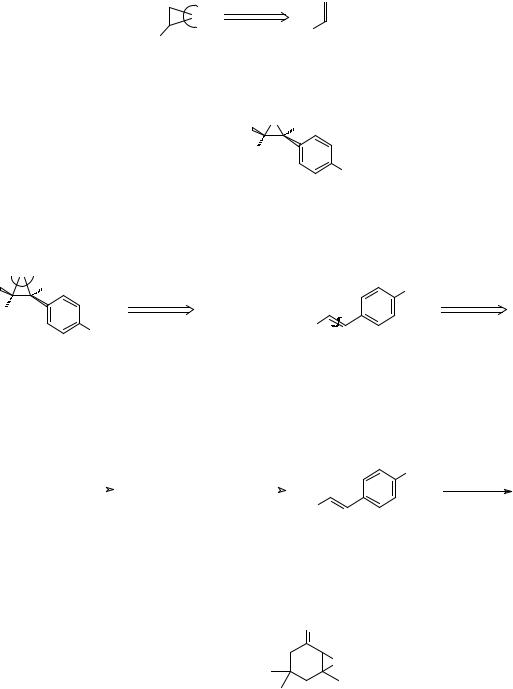
90
..
The synthon X will be, in a lower valency state - if X is C then it will be a carbene or the synthetic equivalent of a carbene. Let's see how this disconnection works out for epoxides. Taking X = O first we have
..
O + " O "
R
Ph
..
A reagent for the synthon is O How then could you make TM 276?
TM 276
a peracid RCO3H.
O
H H
Ph
OMe
_______________________________________
277. Analysis: Using our new disconnection:
|
O |
|
|
H |
H |
|
OMe |
Ph |
|
RCO3H + |
Wittig |
|
|
OMe |
Ph |
|
|
|
Note that is must be the trans olefin as it is the trans epoxide we want. This is all right as the Wittig reaction can easily be controlled to give mostly the more stable trans olefin.
Synthesis:
|
1. Ph3P |
|
ArCHO |
OMe |
|
PhCH2Br |
PhCH = PPh3 |
RCO3H |
TM 276 |
||
|
|
|
2. base |
Ph |
|
_______________________________________
278. The reagent for the synthon O changes when the olefin is electrophilic as in an α,β-unsaturated carbonyl compound: then alkaline hydrogen peroxide (HOO-) is usea. How could you make TM 278?
O
O
TM 278
_______________________________________

91
279. Analysis:
|
O |
|
|
O |
O |
O |
|
|
EtO2C |
|
α,β −unsaturated |
O |
1,5 - di CO |
+ |
|
O |
|
||
|
carbonyl |
|
|
O |
|
A |
|
|
|
O
O
Synthesis: Intermediate A is manufactured but can be made by the route devised here:
|
|
|
|
O |
O |
|
|
|
|
|
|
O |
H+ |
O |
1. |
CO 2Et , EtO- |
H2O2 , base |
TM 278
2. H+/ H2O , heat
spontaneus cyclisation
_______________________________________
280. The alternative disconnection for an epoxide:
O |
.. |
+ |
RCH |
O
R
is also useful for epoxides of α,β-unsaturated carbonyl compounds when it becomes:
O |
+ Cl |
O |
|
R O |
O |
|
This is the Darzens reaction (frames 172-3) (see Norman, p.231 if you want more details). How would you make
CO2Bu-t
TM 280 |
O |
|
_______________________________________
281. Analysis: Using the carbonyl group as a guide:
CO2Bu-t |
|
+ |
Cl |
CO2Bu-t |
|
|
|||
O |
|
O |
|
|
Synthesis: |
|
|
|
|
H+ |
|
ClCH2CO2Bu-t |
|
TM 280 |
O |
O |
t-BuOK |
|
|
|
|
_______________________________________
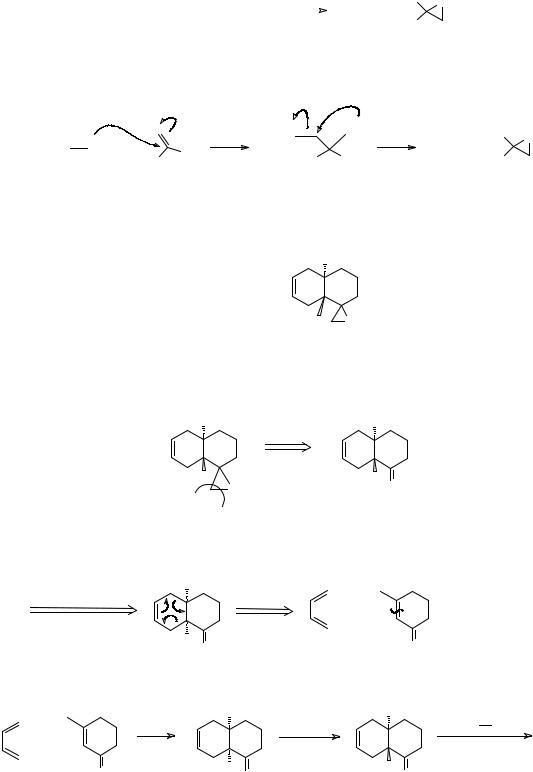
92
282. The same disconnection can be used with simple epoxides when the sulphur ylid (A) is used a reagent for the synthon CH2. Draw a mechanism for the reaction:
+ - |
+ R2C = O |
|
Me2S + |
R |
O |
||
Me2S |
|
CH2 |
|
R |
|
||
|
|
|
|||||
|
(A) |
|
|
|
|
||
|
|
|
|
|
|
||
_______________________________________
283.
+ |
- |
O |
|
+ |
O- |
|
R |
|
|
|
Me2S |
Me2S |
+ |
O |
|||
|
R |
|
||||||
Me2S |
CH2 |
R |
R |
R |
|
|||
|
|
|
R |
|
|
Notice that sulphur ylids behave quite differently from phosphorus ylids, which would of course do the Wittig reaction (frames 41-43).
How could you make TM 283?
Me
TM 283
H O
_______________________________________
284. Analysis: Using our sulphur ylid disconnection:
Me |
|
Me |
H |
O |
H O |
This looks a Diels-Alder product, but the stereochemistry is wrong. However, the centre next to the C=O can be epimerised in base so:
epimerisation |
Me |
D - A |
|
|
|
|
|
|
+ |
|
|
|
|
||
|
|
|
|
used in frame 130 |
|||
|
H O |
|
|
O |
|
|
|
Synthesis: |
|
|
|
|
|
|
|
|
Me |
|
- |
Me |
+ |
- |
|
+ |
|
|
EtO |
|
Me2S CH2 |
TM 283 |
|
|
|
EtOH |
|
|
|
||
|
|
|
|
|
|
||
|
|
|
|
|
|
|
|
O |
H O |
|
|
H O |
|
|
|
|
|
|
more stable trans compound |
|
|
||
_______________________________________
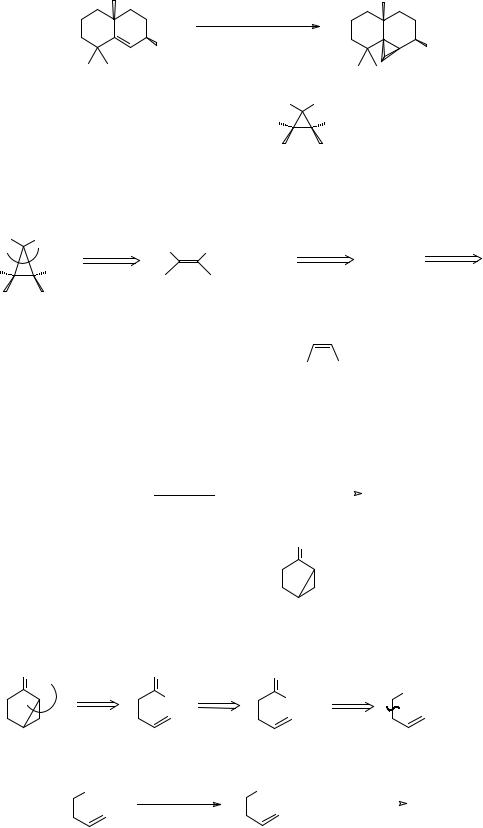
93
285. The same disconnection is also effective for cyclopropanes but the reagent for the carbene synthon is a diazocompound RCHN2 or a dihalo compound treated with a metal e.g.
|
CH2I2 |
, Cu - Zn |
|
OH |
or |
CH2N2 |
OH |
|
|
How then might you make TM 285?
Ph Ph
TM 285 |
H |
H |
_______________________________________
286. Analysis: Two disconnections are possible but the stereochemistry gives us the clue:
Ph |
Ph |
H |
.. |
|
|
|
H |
|
|
||
H |
H |
+ |
Ph2C |
Ph2CBr2 |
Ph2CO |
|
|
|
|
Synthesis:
PBr5
Ph2CO  Ph2CBr2
Ph2CBr2  TM 285
TM 285
MeLi
_______________________________________
287. Diazo compounds are particularly easy to carbonyl group by this reaction:
RCOCl CH2N2  RCO . CHN2
RCO . CHN2
make with the diazo group next to a
Cu ( I ) |
.. |
|
RCO . CH |
|
or light
So how would you make TM 287?
O
TM 287
_______________________________________
288. Analysis: Using the carbonyl group as a guide:
O |
O .. |
O |
CO2H |
|
CH |
|
CHN2 |
as in frame 211
Synthesis:
CO2H |
1. SOCl2 |
COCHN2 |
||
|
|
|
|
TM 287 |
|
|
|
|
|
|
2. CH2N2 |
|
light |
|
Similar to Tetrahedron, 1964, 20, 1870.
_______________________________________
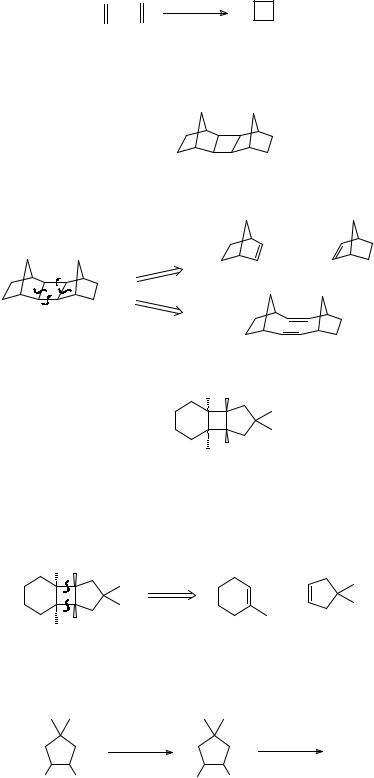
94
2.FOUR-MEMBERED RINGS
289. The most important disconnection for four-membered rings corresponds to the photochemical 2 + 2 cycloaddition of olefins:
light
+
This is the allowed process by the Woodward-Hoffmann rules (see Tedder, Part 3, pp. 383387 or Norman p. 292 ff if you want to know more). There are obviously two disconnections for any given cyclobutane but it is often easy to see the better at once. How would you make:
TM 289
_______________________________________
290. Analysis: The two possibilities are:
+
a |
a |
A |
b  b
b
b
a
Far more is achieved by a, and TM 289 is simply synthesised by irradiating norbornene (A). The stereochemistry turns out all right. How about TM 290?
H H
TM 290
H
_______________________________________
291. Analysis: TM 290 was used by Corey (J. Amer.Chem. Soc., 1964, 86, 1652) in his synthesis of α-caryophyllene alcohol. Again, only one disconnection is very productive:
H H
+
H A B
A is simply made, but the synthesis of B is not straightforward and it turns out that it is best done not from a mono-alcohol, but from a diol:
|
HBr |
|
Zn |
|
|
|
B |
HO |
OH |
Br |
Br |
How might we make the diol (C)?
_______________________________________
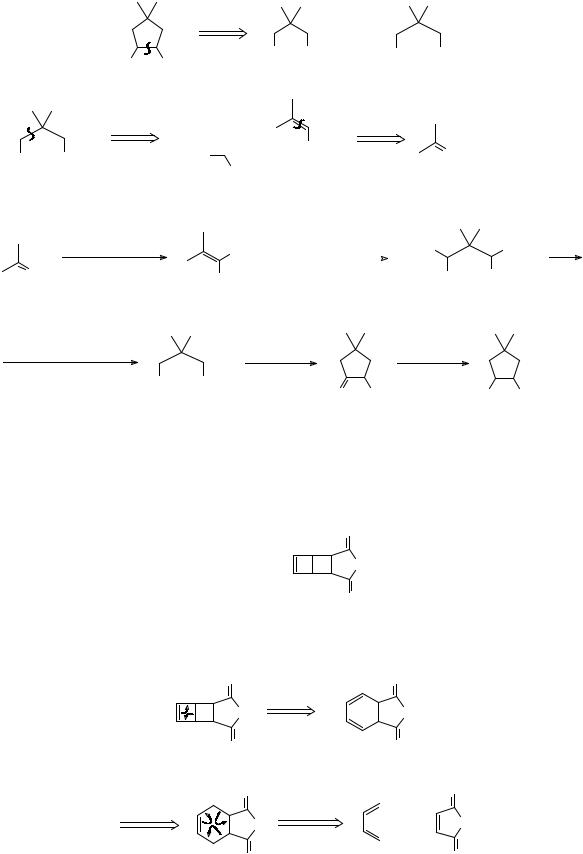
95
292. Analysis: Our methods for making 1,2-dioxygenated compounds (frames 154-157) involve reductive linking of a dicarbonyl compound:
|
|
or |
HO |
CHO CHO |
CO2Et CO2Et |
OH |
|
These are 1,5-dicarbonyls so we shall make them by Michael reactions e.g.
|
+ |
CO2Et |
+ CH2(CO2Et)2 |
CO2Et CO2Et |
EtO2C |
O |
|
|
|
||
|
CO2Et |
|
|
the corresponding sequence with the aldehyde is not so easy to do. So one synthesis for C would be:
|
CH2(CO2Et)2 |
CO2Et |
CH2(CO2Et)2 |
EtO2C |
CO2Et |
O |
+ |
|
- |
|
|
R2NH , H |
CO2Et |
EtO |
|
CO2Et CO2Et |
|
|
|
1. hydrolysis |
|
|
Na |
|
NaBH4 |
|
|
2. decarboxylation |
CO2Et |
CO2Et |
xylene |
|
|
|
|
3. H+/ EtOH |
O |
OH |
HO |
OH |
|||
|
|
(Another version appears in J. Org. Chem., 1959, 24, 2060).
_______________________________________
293. Just to show you that you can’t automatically separate two rings to get the right disconnection (hint!). How could you make TM 293?
O
|
O |
TM 293 |
|
|
O |
_______________________________________ |
|
294. Analysis: Opening the cyclobutene gives this: |
|
O |
O |
O |
O |
O |
O |
Now we need a Diels-Alder reaction so we must shed a double bond:
O |
|
FGI ? |
D - A |
O |
+ |
O |
|
O
O
O
Synthesis: The FGI is easily done and the product was used by Van Tamelen (J. Amer. Chem. Soc., 1963, 85, 3297) in one of the early syntheses of a Dewar benzene:

96
|
O |
O |
|
O |
O |
|
|
|
Br2 |
Br |
base |
|
light |
+ |
|
|
|
|||
O |
O |
|
O |
O |
TM 293 |
|
|
|
|
Br |
|
O |
|
|
O |
O |
|
O |
|
_______________________________________
3.REVIEW PROBLEMS
295. Review problem 28: Design a synthesis for TM 295; an intermediate needed for a trichodermin synthesis.
|
O |
TM 295 |
CO2Et |
|
_______________________________________
296. Analysis: Disconnecting the threemembered ring first:
O |
O |
|
CO2Et |
+ N2CH . CO2Et |
H2NCH2CO2Et |
|
Birch reduction |
|
Synthesis: The route used in Chem. Comm., 1971, 858:
HO |
|
|
|
base |
MeO |
Li , NH3 |
MeO |
H+ |
O |
|
|
|
|
(MeO)2SO2 |
|
t-BuOH |
|
H2O |
|
|
|
|
|
|
|
|
|
|
A |
|
|
|
|
HONO |
|
A |
TM 295 |
|
|
H2N |
. |
CH2 |
. |
CO2Et |
N CH . CO Et |
|
|
||
|
|
2 |
2 |
|
|
|
|||
(glycine ethyl ester)
_______________________________________
297. Review problem 29: Suggest a synthesis of TM 297.
Ph CO . CO2Me
TM 297 |
Ph |
CO . CO2Me |
_______________________________________
298. Analysis: Symmetry suggests that one of the two possible cyclobutane disconnections is better than other:
|
CO . CO2Me |
|
CO . CO |
Me |
α,β − |
|
|
|
Ph |
Ph |
2 |
|
PhCHO |
||||
|
|
unsaturated |
||||||
|
|
+ |
|
|
+ |
|
|
|
|
|
CO . CO2Me |
carbonyl |
|
|
|||
Ph |
CO . CO Me |
Ph |
MeCO |
. |
CO2Me |
|||
|
2 |
|
|
|
|
|
||
